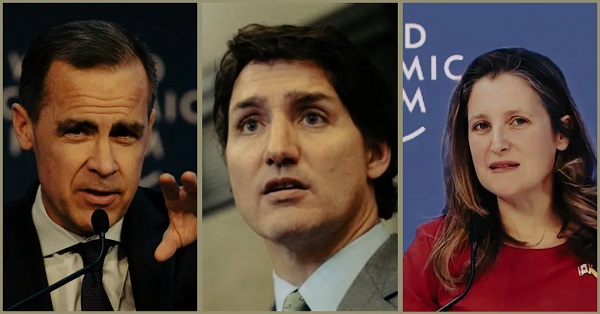Business
StatsCan Confirms Canada’s Middle Class Is Disappearing Under Liberal Mismanagement

A new Statistics Canada report reveals widening income inequality and a shrinking middle class, all while Trudeau’s Liberals push policies that benefit the wealthy and punish working Canadians.
A newly released report from Statistics Canada on household economic accounts for the third quarter of 2024 confirms what many Canadians have long suspected—while the wealthiest continue to rake in profits, middle- and lower-income families are left struggling under the weight of economic policies that seem designed to work against them. The report, released today, paints a stark picture of a country where financial inequality is not just persisting, but growing.
The numbers don’t lie. Income inequality has increased, with the top 40% of earners pulling even further ahead of the bottom 40%. The gap in disposable income between these two groups expanded to 46.9 percentage points, up from 46.3 just a year ago. The highest-income households saw their disposable income rise by 6.8%, largely driven by soaring investment gains, while the poorest Canadians saw only a 3.7% increase, barely enough to keep up with the cost of living. Meanwhile, middle-income earners experienced sluggish wage growth of just 2.7%, well below the national average.
Despite declining interest rates, lower-income households found themselves paying more on mortgages and consumer credit, while the wealthy reaped the benefits of higher investment yields. The data shows that middle-income households, who are already feeling the squeeze from inflation and stagnating wages, saw their share of national income shrink.
The most revealing statistic is in net worth distribution. The top 20% of wealthiest Canadians control nearly two-thirds (64.7%) of the country’s net worth, averaging an eye-watering $3.3 million per household. Meanwhile, the bottom 40% hold just 3.3%, barely scraping by with an average of $83,189 in assets.
However, the real estate market has provided a rare silver lining for some lower-wealth households, as they were able to take advantage of slightly more favorable conditions to buy homes, increasing their net worth at the fastest pace. But even that gain is tempered by the reality that housing costs remain unaffordable for many, and young Canadians under 35 continue to pull back from homeownership altogether.
Let’s be clear—this isn’t happening by accident. This is what happens when you let a government of self-serving narcissists run the country into the ground. Justin Trudeau and his Liberal Party have spent nearly a decade dismantling the Canadian economy, pushing a radical, ideologically driven agenda that benefits their elite donor class while leaving working Canadians behind. And now, as the country crumbles under the weight of their incompetence, Trudeau is running for the exits, leaving the mess to whoever’s foolish enough to take the job.
And what do they do on the way out? Do they work to secure our economy? To make life more affordable? To protect Canadian workers? No. Instead, they decide to pick a fight with the United States. Donald Trump, who actually puts his country first—imagine that—announces a 25% tariff on Canadian imports, a move meant to address drug trafficking and illegal immigration, and what’s the Liberals’ response? Do they try to work out a deal? Do they negotiate in good faith to protect Canadian jobs? No. Instead, Chrystia Freeland comes out swinging, proposing retaliatory tariffs that will hurt Canadian businesses just as much, if not more, than they’ll hurt the U.S.
This isn’t about protecting Canada. This isn’t about securing the border or fighting for our economy. This is about pure, partisan politics. The Liberal base wants conflict with the U.S. Not because it’s good for the country, but because their fragile, self-righteous worldview depends on it. They hate Trump, and they hate that his America-First policies are actually working for American workers. So instead of finding a solution, they escalate. They antagonize. Because their base loves it. Not because Canada benefits, but because Liberals benefit.
Subscribe to The Opposition with Dan Knight .
For the full experience, upgrade your subscription.
And meanwhile, what’s Jagmeet Singh doing? The man who loves to talk about standing up for the working class? He could pull the plug on this corrupt government today with a non-confidence motion. But he won’t. Because, like every other member of the political elite in this country, he’s more interested in protecting his own position than actually doing his job. He makes noise about fighting for Canadian workers, but when the moment comes to act, he folds—again.
So here we are. The economy is in shambles. The wealth gap is growing. The middle class is getting squeezed to death. And the people in charge are too busy playing partisan games to do anything about it. Trudeau is leaving, but his legacy of economic destruction, division, and incompetence will live on through the same out-of-touch Liberal elites who put us in this mess.
But here’s the thing—Canada is better than this. We are a nation built on hard work, freedom, and opportunity, not on government control, reckless spending, and endless excuses. We are a country that thrives when its people—not bureaucrats in Ottawa—decide their own future.
It’s time for Canadians to take their country back. It’s time to put an end to this cycle of economic ruin and government failure. We don’t need more empty promises, more excuses, or more Liberal arrogance. We need an election. We need leaders who believe in the strength of Canadians, not the power of government.
Enough is enough. If we want a future where hard work is rewarded, where families can afford to buy a home, and where our economy is built to benefit all Canadians—not just the elite—then we must act. This country belongs to you, not the Liberal Party, not the special interests, and certainly not the self-serving political class in Ottawa.
Canada deserves better. And the time to demand it is now.
Subscribe to The Opposition with Dan Knight .
For the full experience, upgrade your subscription.
Business
Most Canadians say retaliatory tariffs on American goods contribute to raising the price of essential goods at home

- 77 per cent say Canada’s tariffs on U.S. products increase the price of consumer goods
- 72 per cent say that their current tax bill hurts their standard of living
A new MEI-Ipsos poll published this morning reveals a clear disconnect between Ottawa’s high-tax, high-spending approach and Canadians’ level of satisfaction.
“Canadians are not on board with Ottawa’s fiscal path,” says Samantha Dagres, communications manager at the MEI. “From housing to trade policy, Canadians feel they’re being squeezed by a government that is increasingly an impediment to their standard of living.”
More than half of Canadians (54 per cent) say Ottawa is spending too much, while only six per cent think it is spending too little.
A majority (54 per cent) also do not believe federal dollars are being effectively allocated to address Canada’s most important issues, and a similar proportion (55 per cent) are dissatisfied with the transparency and accountability in the government’s spending practices.
As for their own tax bills, Canadians are equally skeptical. Two-thirds (67 per cent) say they pay too much income tax, and about half say they do not receive good value in return.
Provincial governments fared even worse. A majority of Canadians say they receive poor value for the taxes they pay provincially. In Quebec, nearly two-thirds (64 per cent) of respondents say they are not getting their money’s worth from the provincial government.
Not coincidentally, Quebecers face the highest marginal tax rates in North America.
On the question of Canada’s response to the U.S. trade dispute, nearly eight in 10 Canadians (77 per cent) agree that Ottawa’s retaliatory tariffs on American products are driving up the cost of everyday goods.
“Canadians understand that tariffs are just another form of taxation, and that they are the ones footing the bill for any political posturing,” adds Ms. Dagres. “Ottawa should favour unilateral tariff reduction and increased trade with other nations, as opposed to retaliatory tariffs that heap more costs onto Canadian consumers and businesses.”
On the issue of housing, 74 per cent of respondents believe that taxes on new construction contribute directly to unaffordability.
All of this dissatisfaction culminates in 72 per cent of Canadians saying their overall tax burden is reducing their standard of living.
“Taxpayers are not just ATMs for government – and if they are going to pay such exorbitant taxes, you’d think the least they could expect is good service in return,” says Ms. Dagres. “Canadians are increasingly distrustful of a government that believes every problem can be solved with higher taxes.”
A sample of 1,020 Canadians 18 years of age and older was polled between June 17 and 23, 2025. The results are accurate to within ± 3.8 percentage points, 19 times out of 20.
The results of the MEI-Ipsos poll are available here.
* * *
The MEI is an independent public policy think tank with offices in Montreal, Ottawa, and Calgary. Through its publications, media appearances, and advisory services to policymakers, the MEI stimulates public policy debate and reforms based on sound economics and entrepreneurship.
Business
B.C. premier wants a private pipeline—here’s how you make that happen

From the Fraser Institute
By Julio Mejía and Elmira Aliakbari
At the federal level, the Carney government should scrap several Trudeau-era policies including Bill C-69 (which introduced vague criteria into energy project assessments including the effects on the “intersection of sex and gender with other identity factors”)
The Eby government has left the door (slightly) open to Alberta’s proposed pipeline to the British Columbia’s northern coast. Premier David Eby said he isn’t opposed to a new pipeline that would expand access to Asian markets—but he does not want government to pay for it. That’s a fair condition. But to attract private investment for pipelines and other projects, both the Eby government and the Carney government must reform the regulatory environment.
First, some background.
Trump’s tariffs against Canadian products underscore the risks of heavily relying on the United States as the primary destination for our oil and gas—Canada’s main exports. In 2024, nearly 96 per cent of oil exports and virtually all natural gas exports went to our southern neighbour. Clearly, Canada must diversify our energy export markets. Expanded pipelines to transport oil and gas, mostly produced in the Prairies, to coastal terminals would allow Canada’s energy sector to find new customers in Asia and Europe and become less reliant on the U.S. In fact, following the completion of the Trans Mountain Pipeline expansion between Alberta and B.C. in May 2024, exports to non-U.S. destinations increased by almost 60 per cent.
However, Canada’s uncompetitive regulatory environment continues to create uncertainty and deter investment in the energy sector. According to a 2023 survey of oil and gas investors, 68 per cent of respondents said uncertainty over environmental regulations deters investment in Canada compared to only 41 per cent of respondents for the U.S. And 59 per cent said the cost of regulatory compliance deters investment compared to 42 per cent in the U.S.
When looking at B.C. specifically, investor perceptions are even worse. Nearly 93 per cent of respondents for the province said uncertainty over environmental regulations deters investment while 92 per cent of respondents said uncertainty over protected lands deters investment. Among all Canadian jurisdictions included in the survey, investors said B.C. has the greatest barriers to investment.
How can policymakers help make B.C. more attractive to investment?
At the federal level, the Carney government should scrap several Trudeau-era policies including Bill C-69 (which introduced vague criteria into energy project assessments including the effects on the “intersection of sex and gender with other identity factors”), Bill C-48 (which effectively banned large oil tankers off B.C.’s northern coast, limiting access to Asian markets), and the proposed cap on greenhouse gas (GHG) emissions in the oil and gas sector (which will likely lead to a reduction in oil and gas production, decreasing the need for new infrastructure and, in turn, deterring investment in the energy sector).
At the provincial level, the Eby government should abandon its latest GHG reduction targets, which discourage investment in the energy sector. Indeed, in 2023 provincial regulators rejected a proposal from FortisBC, the province’s main natural gas provider, because it did not align with the Eby government’s emission-reduction targets.
Premier Eby is right—private investment should develop energy infrastructure. But to attract that investment, the province must have clear, predictable and competitive regulations, which balance environmental protection with the need for investment, jobs and widespread prosperity. To make B.C. and Canada a more appealing destination for investment, both federal and provincial governments must remove the regulatory barriers that keep capital away.
-

 COVID-194 hours ago
COVID-194 hours agoFDA requires new warning on mRNA COVID shots due to heart damage in young men
-

 Business2 hours ago
Business2 hours agoCarney’s new agenda faces old Canadian problems
-

 Indigenous3 hours ago
Indigenous3 hours agoInternal emails show Canadian gov’t doubted ‘mass graves’ narrative but went along with it
-

 Bruce Dowbiggin5 hours ago
Bruce Dowbiggin5 hours agoEau Canada! Join Us In An Inclusive New National Anthem
-

 Bruce Dowbiggin2 days ago
Bruce Dowbiggin2 days agoThe Covid 19 Disaster: When Do We Get The Apologies?
-

 Business2 days ago
Business2 days agoCannabis Legalization Is Starting to Look Like a Really Dumb Idea
-

 Media2 days ago
Media2 days agoCBC journalist quits, accuses outlet of anti-Conservative bias and censorship
-

 Business2 days ago
Business2 days agoCarney government should recognize that private sector drives Canada’s economy








